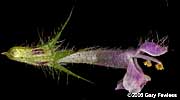
Invasive Plants of Wisconsin
|
Galeopsis tetrahit is one of many species in the mint family in Wisconsin. Leaves are simple, toothed and opposite. The corolla is tubular, bilaterally symmetrical and may be white or pink. The calyx lobes have conspicuous spiny tips, which become even stiffer as they mature. The stem is bristly and may have an enlarged area below each node. Each ovary is comprised of four lobes, each of which matures to become a hard, single-seeded nutlet. Galeopsis tetrahit has been in Wisconsin since at least as early as the 1940's and I have seen it in northern Wisconsin since the 1960's. It seemed to be a disturbed soil, roadside/field/yard kind of a plant and not very aggressive in my experience. However in recent years it has begun to spread from forest roadsides into the adjacent forests and is now clearly a serious invasive. It spreads rapidly along skid trails, scrapes and new roads, but is also found very widely in mesic forests of northeastern Wisconsin, and perhaps more broadly. This species is an annual and depends completely on seed production to persist and increase on a site. There is no evidence of vegetative reproduction and no published eveidence for allelopathy to the best of my knowledge. There are no clear mechanisms for dispersal to new sites. It is likely that operation of machinery in the forest, resulting in exposed mineral soil, aid the spread of this species. The exposed soil provides open habitat for the plants and the seeds in soil attached to machinery may very well be the means for spreading the seeds from existing sites to the new disturbances. Forest soils that have been cleared of the layer of decomposing leaves by alien earthworms also appear more favorable to the spread of hemp-nettle. |
|












